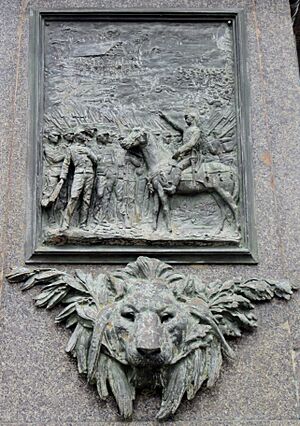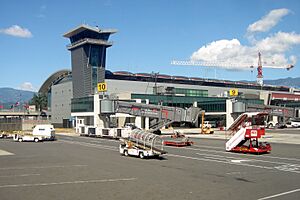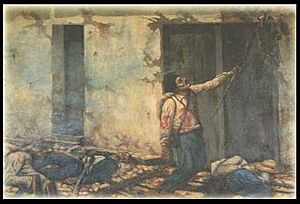Juan Santamaría facts for kids
Quick facts for kids
Juan Santamaría
|
|
|---|---|
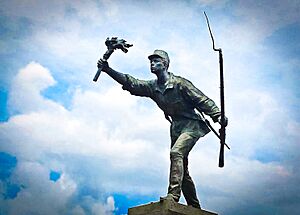
Statue of Juan Santamaría in Alajuela.
|
|
| Born |
Juan Santamaría Rodríguez
August 29, 1831 |
| Died | April 11, 1856 (aged 24) |
| Cause of death | Gunshot wounds |
| Nationality | Costa Rican |
| Occupation | Drummer |
| Known for | National hero of Costa Rica |
| Military career | |
| Allegiance | |
| Battles/wars |
|
Juan Santamaría Rodríguez (born August 29, 1831 – died April 11, 1856) was a brave drummer in the Costa Rican army. He is known as the national hero of Costa Rica. He earned this title for his actions during the 1856 Second Battle of Rivas, which was part of the Filibuster War.
Juan Santamaría died in battle while carrying a torch. He used it to set fire to an enemy building. This helped Costa Rica win against an American adventurer named William Walker and his army. Many years after his death, people started to see him as a hero. His story helped inspire Costa Ricans to feel proud of their country. Every year on April 11, Costa Rica celebrates Juan Santamaría Day. This is a special holiday to remember his sacrifice.
In 1891, a large bronze statue of Juan Santamaría was put up in his hometown, Alajuela. The main airport in Costa Rica and a museum in Alajuela are also named after him. Many books, songs, and artworks have been made to honor him. Historians have also studied his life to learn more about him.
Contents
Juan Santamaría's Early Life
Juan Santamaría was born in Alajuela on August 29, 1831. His mother was María Manuela Santamaría. His father's name is not known. He went to elementary school in Alajuela. From a young age, he started working.
Juan had many different jobs in Alajuela. He sold sweets, worked as a laborer, and picked coffee. Later, he became a drummer in Alajuela's military band. This led him to become a drummer for the Costa Rican Army. He served as a drummer boy until he died in the Second Battle of Rivas. This was the battle where he performed his heroic act.
Fighting for Costa Rica: The Filibuster War
The Filibuster War began because of a man named William Walker. He was an American adventurer who wanted to take over countries. In 1856, he took control of the government in Nicaragua. Then, he tried to conquer other nations in Central America, including Costa Rica. He wanted to create his own large territory.
Costa Rican President Juan Rafael Mora Porras asked everyone to join the army. He told them to march north to Nicaragua to fight against Walker. This started the Filibuster War. Juan Santamaría was a poor worker. He was raised by a single mother. He joined the army as a drummer boy. The soldiers gave him a nickname, "el erizo," which means "the hedgehog." They called him this because of his spiky hair.
After defeating some of Walker's soldiers at a farm called Santa Rosa, the Costa Rican troops kept marching. They reached the city of Rivas, Nicaragua, on April 8, 1856. The fight that happened there is known as the Second Battle of Rivas.
The Battle of Rivas
The fighting was very intense. Walker's men were hiding in a building in the town center. From there, they had a good position to shoot at the Costa Ricans. The Costa Rican soldiers could not force them out.
According to the famous story, on April 11, a general named José María Cañas had an idea. He suggested that a soldier should run to the building with a torch. The soldier would then set it on fire. Some soldiers tried but failed. Finally, Juan Santamaría volunteered. He had one condition: if he died, someone must take care of his mother.
Juan then ran forward. He was shot and badly wounded by enemy fire. But before he died, he managed to set the building on fire. This act helped Costa Rica win the battle at Rivas.
Juan Santamaría's mother asked the government for money in 1857. Government papers show that she received this money. This supports the traditional story. However, some historians have wondered if the story is completely true. They have looked into whether Juan Santamaría died in different ways. But by the late 1800s, Costa Rican thinkers and leaders used his story. They wanted to make people feel proud of their country and unite them.
Becoming a National Hero
After Juan Santamaría's death, the Filibuster War continued. Eventually, William Walker and his forces were defeated. But Juan Santamaría's brave actions were not talked about much until 1885. This was 29 years after he died.
His name first appeared in a national newspaper called El Diario de Costa Rica. The article was titled "Un Héroe Anónimo" (An Anonymous Hero). This article was written because Guatemala's leader, Justo Rufino Barrios, was threatening Costa Rica. Barrios wanted to force Central American countries to unite. "Un Héroe Anónimo" talked about Santamaría's sacrifice. It also mentioned two other generals from the Filibuster War. The goal was to inspire Costa Ricans to defend their country.
How Juan Santamaría Became Famous
This call to action was printed in other newspapers. The President of Costa Rica at the time said a new national ship would be named "The Juan Santamaría." Juan Santamaría became a symbol. Costa Rican leaders used his story to create a national identity. They wanted to gather support to protect Costa Rica's freedom.
Costa Rican troops never actually fought against Guatemalan forces. Barrios was defeated by troops from El Salvador. But Juan Santamaría's story remained important to Costa Rica's identity. He was soon declared a national hero. Through newspapers, festivals, and school lessons, Juan Santamaría became a symbol of Costa Rica.
A Hero for Everyone

Costa Rica's Independence Day is September 15. This day celebrates when Central America became free from Spain in 1821. But Costa Rican independence is also strongly linked to Juan Santamaría. It is also linked to the Second Battle of Rivas and the Filibuster War. This is because it was the only time the country fought to stay a free nation.
In 1891, on September 15, a statue of Juan Santamaría was put up in Alajuela. This was to remember him. On many Independence Day celebrations after that, the government honored Juan Santamaría. They celebrated his bravery in the fight against William Walker. Also, April 11, the day he died, is a national holiday called Juan Santamaría Day.
Juan Santamaría came from a humble background. He was a low-ranking soldier. This made him a hero who represents the everyday people of Costa Rica. Many people feel that Santamaría was "one of them." This connection makes his story special to many. It makes them support him even more as a national hero.
Remembering Juan Santamaría
On September 15, 1891, the government revealed a large bronze statue of Juan Santamaría. It is in the park in Alajuela named after him. The Costa Rican government ordered the statue. A French artist named Aristide Croisy made it.
Statues and Monuments
Around the bottom of the statue are pictures. They show Santamaría volunteering to his leader. They also show him dying while setting the building on fire. Underneath these pictures are lion heads. These symbolize strength and courage.
At the statue's unveiling, there was a parade. The President, important church leaders, governors, and foreign guests attended. Families of other Costa Rican heroes were also there. There were musical performances and speeches. These speeches highlighted his heroism and sacrifice. Some even compared him to Christ.
Other statues of Juan Santamaría can be found. One is outside the Costa Rican Embassy in Spain. Another is in front of the Costa Rican National Congress in San José.
The Airport and Coat of Arms
The coat of arms (symbol) of Alajuela was changed in 1908. It now shows a hand holding a torch. This symbolizes Juan Santamaría's heroic act. He carried the torch to burn down the enemy stronghold in the Second Battle of Rivas.
The international airport is in Alajuela. This is Santamaría's hometown. The airport serves San José, the capital city of Costa Rica. It was also named after him.
The Song of Juan Santamaría
In 1891, Pedro Calderón Navarro and Emilio Pacheco Cooper wrote a song. It is called Himno Patriótico A Juan Santamaría, 11 De Abril. This patriotic song is about Juan Santamaría. It was sung for the first time when the Juan Santamaría Statue was unveiled. This happened on September 15, 1891.
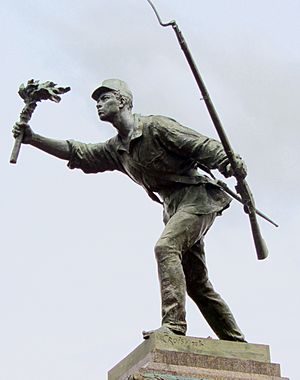
Was Juan Santamaría Real? The Historical Debate
Historians and scholars have different ideas about Juan Santamaría. There is no single, agreed-upon story of his exact identity. So, the discussion about whether he truly existed continues today.
Some proof for his existence includes his baptismal certificate. There are also documents showing his name on a list of soldiers from Alajuela. His mother's request for a pension also supports his story.
The first writings about Juan Santamaría were by José de Obaldía and Álvaro Contreras Membreño. In their essays, they called Santamaría "glorious" and a "sublime martyr." They said he gave his life for Costa Rica. Their articles were not just to tell his story. They also aimed to unite the people against a threat to their country's freedom. This goal influenced how Santamaría was shown.
Even though he was of mixed race, his story became very popular. But in pictures and statues, he was often shown as white. For example, in the famous bronze statue, he looks white. He is also wearing a French soldier's uniform. This made him seem more white. When Santamaría was first celebrated, Costa Rican leaders wanted to show the country as united. This led them to show Juan Santamaría as white.
This different way of showing him made many historians question if he was a real person. To prove Santamaría was real, the city of Alajuela gathered witnesses. Fellow soldiers said he was real. They also said he died burning down the enemy building in Rivas. The city of Alajuela also provided documents. These included his birth certificate and his mother's request for money from the government. All these documents and statements were put together in a book called El Libro del Héroe (The Book of the Hero).
Also, Santamaría's baptismal certificate was found. It was from a church in Alajuela. It had his name and his mother's name, María Manuela Santamaría. The certificate said his father's name was unknown. This supports the story that Santamaría was raised by a single mother. Two more documents that historians use to prove he existed are in the [Costa Rican national archives]. These are two separate lists of soldiers from Alajuela. Juan Santamaría's name can be seen on both.
However, one document makes some people doubt the story of Juan Santamaría's actions. This document lists the names and causes of death for soldiers. It was written in 1858 by the army's chaplain, Priest Rafael Francisco Calvo. It listed a man named Juan Santamaría from Alajuela who died from cholera. Cholera was a common and deadly illness back then.
A doctor who lived with Calvo later in his life, Rafael Calderón Muñoz, said he asked the priest about the man who died of cholera. Calvo claimed it was a different Juan Santamaría than the hero. Other documents support Calvo's claim. A military count listed five different people named Juan Santamaría from Alajuela. Another report of deaths between April and May 1856 listed a Juan Santamaría who died in Rivas.
Even with these questions, there is a strong and consistent oral tradition. Many people have passed down the story that Juan Santamaría existed. They believe he was at the Second Battle of Rivas. They also believe he was one of the people who helped burn down the building, and that he died doing it.
See also
 In Spanish: Juan Santamaría para niños
In Spanish: Juan Santamaría para niños


